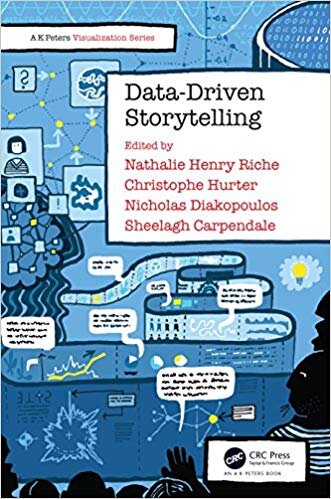Data-Driven Storytelling
Nicholas Diakopoulos, Nathalie Henry Riche, Christophe Hurter, and Sheelagh Carpendale have edited this accessible introduction to data-driven storytelling. It offers an integrated definition of the topic, presents vivid examples and patterns for data storytelling, and calls out key challenges and new opportunities for researchers and practitioners. Nicholas Diakopoulos has also co-edited two of the chapters.
Chapter 1: Introduction
By Nicholas Diakopoulos, Nathalie Henry Riche, Cristophe Hurter and Sheelagh Carpendale
Today, data visualizations are everywhere. They form a significant and often integral part of contemporary media. Stories supported by facts extracted from data analysis proliferate in many different ways in our analog and digital environments including printed infographics in magazines, animated images shared on social media, and interactive online visualizations tightly integrated with news stories on leading media outlets. However, while data visualization may be at the heart of data-driven stories, the concepts are not synonymous. We explore these distinctions in this book.
Chapter 9: Communicating Data to an Audience
By Nicholas Diakopoulos, Steven M. Drucker, Robert Kosara, Jonathan Schwabish and Samuel Huron
Communicating data in an effective and efficient story requires the content author to recognize the needs, goals, and knowledge of the intended audience. Do we, the authors, need to explain how a chart works? It depends on the audience. Does the data need to be tracked back to its source? Depends on the audience. Can we skip obvious patterns and correlations and dive right into the deeper points? Depends on the audience. And so on. Thus, to effectively communicate ideas and concepts, content authors need to think carefully about how their work best fits the needs of the audience. This chapter explores design considerations relating to audience knowledge and goal contexts, and considers the difference between the theory of what we might know and the reality of what we can know.
Chapter 10: Ethics in Data-Driven Visual Storytelling
By Nicholas Diakopoulos
Many questions that relate to ethics arise in data-driven storytelling. Is the sample representative, have we thought of the bias of whoever collected or aggregated the data, can we extract a certain conclusion from the dataset, is it implying something the data does not cover, does the visual device, or the interaction, or the animation affect the interpretation that the audience can have of the story? These are questions that anyone that has produced or edited a data-driven visual story has, or at least should have, been confronted with. After introducing the reasons and implications of ethics in this book, this chapter looks at the risks, caveats, and considerations at every step on the process, from the collection/acquisition of the data to the analysis, presentation, and publication, with many points illustrated through an example of an ethical consideration.
Find the book here.
Diakopoulos, Nicholas et.al. 2018. “Introduction”. In: Data-Driven Storytelling. Edited Book by Henry Riche, Nathalie, et.al. A. K. Peters, CRC Press.
ISBN 9781138197107

